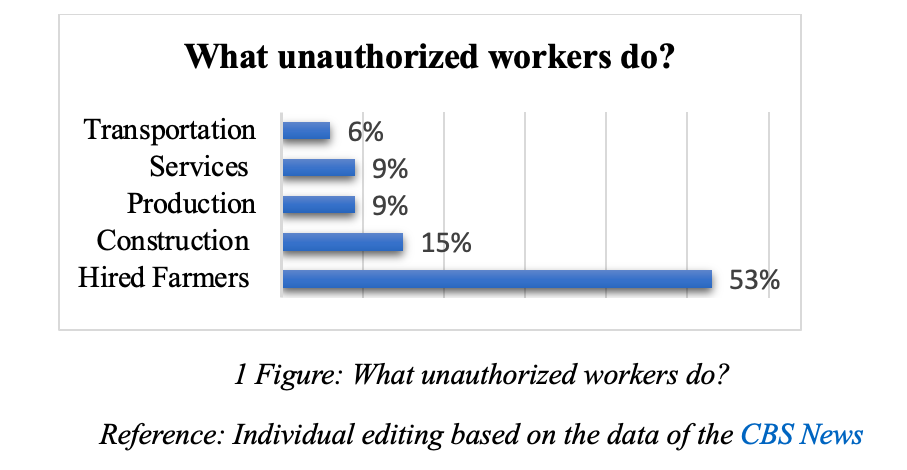Certain industries, such as agriculture or construction, heavily rely on the labor of these individuals. The aim of this article is to address the question posed in the title: 'Does the US economy need undocumented Mexican workers?' To provide an appropriate response to this research question, the paper will be divided into three parts leading up to the final conclusion. The first part will briefly introduce Mexican migration and its generational impacts on the USA, the second part will discuss the sectoral impact of undocumented workers, primarily Mexicans, and the third part will share my personal experiences from spending time in both the US and Mexico.
Mexican Migration to the USA: Past, Present, and the Generational Impact
Starting around the 1890s, the emergence of new industries in the US Southwest, particularly in mining and agriculture, began to draw the first Mexican laborers. The influx increased significantly during the Mexican Revolution (1910-1920). The favourable view of Mexican laborers in the past, driven by their perceived traits of docility, reserve, and physical robustness, was rooted in the expectation that they would serve as temporary migrants, eventually returning to Mexico.
Turning to the present Mexican migration to the United States remains a contentious issue with long-lasting effects on Mexico's economy. The main reason for Mexicans moving to the United States is to improve their financial prospects. While family connections in destination cities are also a factor, economic opportunities between the two countries often outweigh familial ties.
Determining the extent of the undocumented population in the USA presents a substantial challenge. According to current data from the Pew Research Center, approximately 5% of the US workforce consists of undocumented workers. However, these estimates can vary significantly depending on the methodology used. Additional data from the Migration Policy Institute indicates that in 2021, there were an estimated 11.2 million unauthorized immigrants residing in the USA, marking an increase from the 11 million recorded in 2019. This surge represents the most significant increase in unauthorized immigration since 2015. Mexico continued to be the primary source country for unauthorized immigrants, contributing to approximately 46% of the total in 2021. However, it's worth noting that the number of unauthorized Mexican immigrants in the USA is declining sharply, primarily because more have left the USA than arrived.
Roberto Gonzales, a sociology professor at the University of Pennsylvania specializing in the study of undocumented immigrants' circumstances, highlights that the children of undocumented migrants are acutely aware of the significant sacrifices their parents have made for them. When undocumented workers have a child in the USA, the child is automatically granted US citizenship under the law. However, their parents, classified as illegal aliens, do not enjoy the same rights as their US-born children and may face deportation. Consequently, these children often feel a strong, unspoken duty to succeed and improve their circumstances while helping their parents. The commitment to advancement is also evident in the new generations of Mexicans, as they attain higher levels of education than their immigrant ancestors, even though they still fall behind native-born individuals. Their higher level of education, combined with their legal status in the United States, further contributes to their improved opportunities to secure higher-value-added jobs compared to their parents.
Undocumented Workers and Their Contribution to US Industries
Despite the possible consequences (fines, deportation etc.) illegal work has become significant in some labour-intensive sectors of the U.S. economy, as illustrated in the figure below. Undocumented workers, primarily Mexicans, contribute to sectors such as construction, agriculture, and childcare, engaging in activities such as building construction, fruit harvesting, and childcare services.
It's important to highlight that over half of the farmers employed are undocumented, which means agriculture relies to the greatest extent on these workers. However, this heavy reliance on undocumented labor isn't beneficial for either workers or employers. Yet, if these workers were compelled to leave, it would have even more severe consequences for our food supply, and it wouldn't be fair considering their significant contributions. For example, in the dairy industry, removing foreign-born workers could nearly double retail milk prices. The risk is similar for the US fruit, vegetable, and meat industries, where a loss of unauthorized workers could lead to reduced production and potentially higher prices for consumers.
The construction sector may not depend on undocumented workers as much as agriculture, but it still relies heavily on them. Many stakeholders within the construction sector, faced with a scarcity of skilled labor, are advocating for immigration reforms that grant legal status and an increase in temporary visas. This argument is closely tied to one of the predominant strategies for promoting economic development in the US, which involves providing legal status and a path to citizenship. Legal status could provide protection under the law, potentially making it easier for individuals to access education and training, which could lead to higher wages and increased productivity. What will legally happen to these individuals is not a foregone conclusion at this point. However, one thing is certain: as seen in the figure, these workers have become indispensable in various sectors.

The Role of Immigrants in the American Workforce: Personal Experiences and Insights
In general, Americans widely agree that both undocumented and documented immigrants often take on jobs that many Americans are unwilling to do. With this in mind, I would like to continue and share my personal experiences of living and working in the United States and spending a couple of days in Mexico.
I worked at a luxurious hotel in a remote area of Virginia State, where about half of the workforce came from Latin America and Jamaica. They were mainly employed in the kitchen, laundry, or maintenance, earning minimum wage. Despite receiving minimal wages, they deeply appreciated their jobs and willingly took on roles that many Americans wouldn't consider. They arrived on work visas after a rigorous selection process and usually worked at the hotel for nearly a year before returning to their home countries, as working without proper documentation wasn't possible in the hotel. However, it is also likely that, once their legal work is finished, they might prefer to 'disappear' in the USA rather than having to go back home.
After my time at the hotel, I travelled to Mexico, where I had the chance to talk to local residents. Many of them aspired to leave Mexico and go to the USA for better salaries. During a festival on Mexican Independence Day, I had a deep conversation with a Mexican construction worker who had lived illegally in the United States for over a decade. He had been caught, deported, and separated from his family, who were allowed to remain in the United States. He honestly expressed that, as a construction worker in America, he earned more in a few days than he did in an entire month in Mexico. This stark economic disparity illustrated why many individuals sought opportunities in America, hoping for a better quality of life.
Conclusion
In conclusion, it is evident that the U.S. economy heavily depends on the contributions of undocumented immigrants, particularly those of Mexican origin, within the agricultural and construction sectors. As discussed, the newer generations of Mexican Americans, thanks to their higher education levels, are less inclined to engage in physically demanding and lower-value-added jobs in these industries. Consequently, the labor of undocumented Mexicans continues to be indispensable for carrying out many essential tasks in these sectors.
For companies, as long as it doesn't come to light, employing undocumented workers often could presents a more cost-effective option compared to hiring legally authorized employees. This is because undocumented workers typically do not benefit from a broader range of rights and protections (e.g., labor laws), which could, among other things, contribute to an increase in their wages
Finally, it can be concluded that the U.S. economy, as it stands today, cannot function without the undocumented Mexican workforce. However, it is important to acknowledge that the current reliance on undocumented labor is not a sustainable long-term solution. The question of who will ultimately be granted some form of legal work status is poised to become a significant topic in political debates. Addressing this issue and potentially reforming immigration laws in the U.S. will be crucial. Dependence on individuals staying in the country without legal status is not a viable long-term strategy for the economy.









